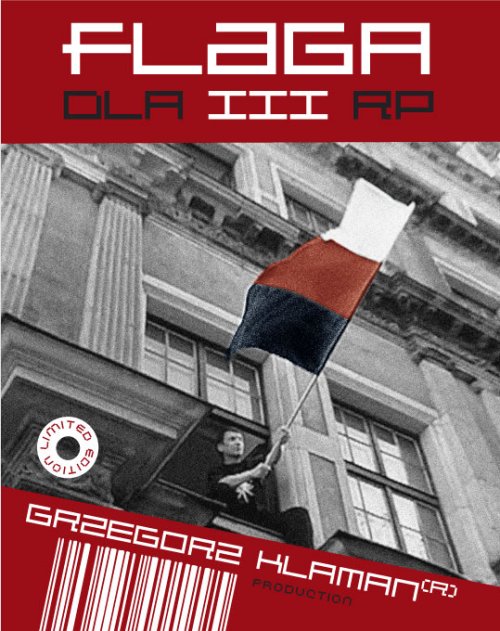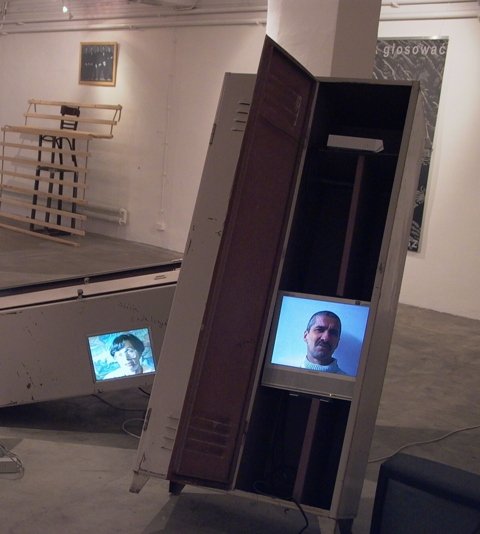The artist's early attitudes and perceptions were shaped by his close-up view of the rise and, shortly thereafter, the fall of the Solidarity movement. He shared in the general enthusiasm that accompanied the movement's birth and in the protests that came with its suppression during Martial Law. He participated in demonstrations, co-edited underground publications and painted protest murals.
In 1980 Klaman graduated from the State High School of Visual Art Techniques in Zakopane. He became a student of the Sculpture Department of the State Higher School of the Visual Arts (today the Academy of Fine Arts) in Gdańsk, which he completed in 1985. Klaman created his thesis project under the direction of Professor Franciszek Duszeńka. Upon completing his studies, he began to teach at his alma mater. He proceeded through all of the levels of an academic career and is currently a professor of the Academy of Fine Arts in Gdańsk.
Between 1984 and 1986 he worked with Kazimierz Kowalczyk in creating colossal and simultaneously ephemeral works at various sites in the city of Gdańsk, an activity that formed a part of the so-called Rotacyjna Gallery (Rotating Gallery) Klaman also created installations made of 'impoverished', perishable materials. These included Underground (1986), Napromieniowany / Radiated (1986), Człowiek / Human (1986) - the latter being joint projects with Kazimierz Kowalczyk. In his sculptures of the 1980s, Klaman favored figurative art that was dramatic in its expression in the spirit of 'new expressionism'. He sculpted raw, monumental figures that he extracted from tree trunks using strokes of the axe and chisel. These were poly-chromed carelessly and usually combined with elements made of sheet metal, wire mesh, fabrics, plastic, and the like (Patrzący / Gazing Figure, 1986, Big Man 1986, Golem, 1987, Czerwony płaszcz / Red Coat, 1987, Burzyciel / Destroyer, 1987). In 1987 he began situating his sculptures on plinths or near other monumental structures (Postać trzymająca los / Figure Holding Fate, 1987 and a variation on this work titled Nowy Budda / New Buddha, dating from 1988 and purchased for the Olympic Sculpture Park in Seoul, South Korea). In the years 1989-1991, he created monumental projects of bent, irregular sheets of metal. These took the form of Obeliski / Obelisks (exhibition titled Na obraz i podobieństwo / In Image and After Likeness, Warszawa 1989), Labirynt / Labyrinth (exhibition titled Labirynt - przestrzeń podziemna / Labyrinth - an Underground Space, Warsaw, 1989), Rotunda / Rotunda, Tunel / Tunnel, Rampa / Ramp, Brama / Gate (exhibition titled Raj utracony / Paradise Lost, Warsaw, 1990), and Góra / Mountains (exhibition titled Epitafium i siedem przestrzeni / Epitaph and Seven Spaces, Warsaw, 1991).
Two factors prompted the change that occurred in his art around 1990. The first was the experience Klaman had gained as an organizer. Beginning in his student years, he had been creating galleries as well as outdoor sites of artistic activity for himself and a group of his peers. These were, in sequence, the Rotacyjna Gallery, located at various sites around the city of Gdańsk (1984-1986), the Baraki / Barracks at Chmielna Street (turn of 1986/87), the Wyspa Gallery on the peninsula known as Granary Island (1987-1994), the Wyspa Gallery at the art school dormitory on Chlebnicka Street (1990-2002), and the Open Atelier in the former Municipal Bathhouse (1992, known as the Łaźnia Contemporary Art Center since 1998). All of these forms, which were institutionalized to a greater or lesser degree, chose the public space as the terrain of their activity. The group of young artists who created works therein, which apart from Klaman included Kazimierz Kowalczyk, Jacek Staniszewski, Eugeniusz Szczudło, Jarosław Filiciński and Robert Rumas, posited themselves as partners of the ruling authority (under both political systems that reigned throughout these years) thereby eliciting a usually unfavorable reaction from authorities. The chasm that existed between the two sides became apparent with the failed attempt at defending Granary Island, threatened with commercial development, for the arts. This was the purpose behind the international symposiums titled Project Wyspa organized in 1992 and 1994 by Klaman and Agnieszka Wołodzko. Klaman's criticism and sensitivity to manifestations stereotypical thinking, stagnation, or simply the corruption of authorities found expression in art forms that were monumental, dominating, cold, and quasi-architectural (see the series Monumenty / Monuments, 1991-1993, Konstrukcje / Structures, 1991-1993, Budowle / Buildings, 1993, Eter / Ether, 1993, and the installation Pneuma at Main Town Hall in Gdańsk, 1996). At the same time, the essential message of these works is not contained in their shape or the expression of their smooth, metal surfaces, but in added details like human hair, natural sounds, photographs, slide and video projections, and the like. The ideological current in these works, designed to 'retaliate' against authorities, was best expressed in a leaflet campaign titled Anatomia polityczna ciała / Political Anatomy of the Body, 1995, carried out in Berlin and involving the handing out of leaflets bearing messages drawn from the work of Michel Foucault. Klaman referred to the Polish situation strictly in a design for the national flag, in which the white and red fields were supplemented with a band of black, symbolizing the influence of the Catholic Church on the State.
A second factor eliciting change were the artist's theoretical interests in contemporary times and the future, and in particular in the problems of power, technology and medicine on one hand, and the body as a subject of study and manipulation on the other. The artist explored these issues in a manner deprived of all symbolism, reference to tradition or conventional ways of thinking, which often caused them to be rejected by critics and even censored at times. This was especially true of works in the series Emblematy / Emblems, 1993 and Katabasis / Cathabasis, 1993, for which he used preserved human organs, including intestines, a brain and a liver, as well as an eye, ear and tongue (communication organs). Transferring the preserved items from the context of the laboratory to a gallery space gave rise to objections that were variously motivated through aesthetic and religious criteria. In the artist's opinion, however, in our age of transplants, cloning and genetic manipulation, these objects are merely indicators of a not too distant everyday reality, in which the type and scope of 'life' decisions will be altogether different. This line of thinking was reconfirmed in Klaman's newest series of objects titled Biblioteki / Libraries, 1999, and Anatrophy, 2000.
In recent years the artist has shown that he is far from abandoning his public activity. For the celebrations of the 20th anniversary of 'Solidarity' in the year 2000, Klaman constructed a monumental form that stood at the entrance to an exhibition titled Droga do wolności / Road to Freedom held within the Gdańsk Shipyard. The shipyard - which is perhaps on the way to being changed in the same manner as Granary Island was - is also the subject of his project titled City Transformers, 2002.
Important exhibitions and awards:
- 1985 - I Biennale Sztuki Nowej / 1st Biennial of New Art, Zielona Góra
- 1986 - Ekspresja lat 80-tych / Expression of the 1980s, BWA (Office of Art Exhibitions), Sopot
- 1987 - Co słychać / What's Up, Former Norblin Factory, Warsaw
- 1988 - Realizm radykalny. Abstrakcja konkretna / Radical Realism - Concrete Abstraction, National Museum, Warsaw
- 1990 - Raj utracony / Paradise Lost, Centre for Contemporary Art, Warsaw
- 1995 - Award of the Mayor of the City of Gdansk for the programs of the Wyspa and Łaźnia galleries
- 1996 - Pollock-Krasner Foundation Scholar; Survival - 6th Rauma Biennale Balticum, Rauma (Finland)
- 1997 - Kolekcja Sztuki Współczesnej na 1000-lecie Gdańska / A Collection of Contemporary Art for the 100th Anniversary of the City of Gdansk, former Municipal Bathhouse, Gdansk
- 2000 - Figura w Rzeźbie Polskiej XIX I XX wieku / The Figure in Polish Art of the 19th and 20th Centuries, Oronsko - Warsaw
- 2000 - 2001 Na wolności \ W końcu / Free \ At Last, Baden-Baden - Warsaw
- 2001 - In Between - Art in Poland 1945-2000, Chicago Cultural Center, Chicago
- 2002 - Niebezpieczne związki / Dangerous Liaisons, Arsenal Municipal Gallery, Poznań
- 2007 - Fear and Trembling, Schmidt Center Gallery –Public Space, Florida Atlantic University, Boca Raton USA
Updated: October 2006
Photos courtesy of the Artist.

Anatrophy II 2000

Flag for Third Polish Republic
Grzegorz Klaman's action realised in the Wyspa Gallery in Gdańsk on 8 May 2001. It was a protest against the ban on placing a three-colour flag, being an exhibition element, on the facade of the Art Academy building which accommodated the Gallery.

Nuptials of the Flag 2001

Solidity, "Health & Safety" [BHP] exhibition, Wyspa Institute of Art, 2004
The installation consists of 2 channel video footage [20' each], workers' lockers and vinyl lettering "Solidity". Two former employees of Gdansk Shipyard, now retired and involved activists were interviewed for the work, what gives a voice to those forced out the current political and economic discourse. One of them is Alina Kowalczyk, former activist pf Solidarność, now the President of Solidarni z Kolebki Association and Hans Szyc, former director of the Shipyard, now President of Retired and Emeritus Section of Solidarność Gdańsk District. Two voices merge into the stream of resentfulness, disappointment and disagreement - the shared by many who used to fight for freedom and now are not able to accommodate to the current social and political situation.

Symbol/Pain 2004
"UN Real" exhibition in ISW, Gdańsk

Lech Wałęsa Commemorative Hall 2005
Author: Maryla Sitkowska, Museum of the Academy of Fine Arts in Warsaw, January 2003.